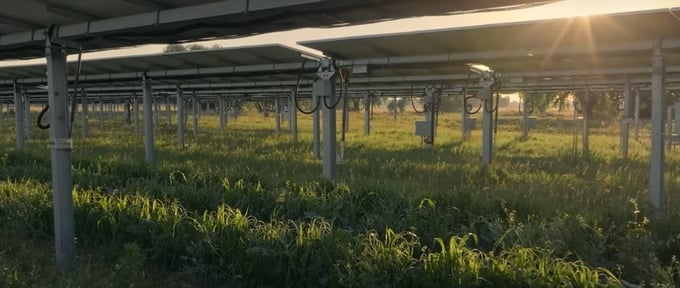May 19, 2025 | 01:58 GMT +7
May 19, 2025 | 01:58 GMT +7
Hotline: 0913.378.918
May 19, 2025 | 01:58 GMT +7
Hotline: 0913.378.918

Agrivoltaic installation at Jack's Garden in Longmont, Colorado.
Agrivoltaics, the combination of farming practices with energy produced by solar photovoltaics (PV), is forecast to become a $9.3 billion marketplace by 2031, growing at a compound annual growth rate (CAGR) of 10.1% in that timeframe from $3.6 billion a year ago.
According to a research note by Allied Analytics, experts believe agrivoltaics can minimize barriers to food security and the transition to clean energy. While the agrivoltaics market is still in the growth stages, it is expected to grow as the solar market continues to boom, owing to demand for clean energy and sustainability.
The agrivoltaics sub-sector market has seen progress as the industry learning curve grows around best use cases in recent years, with the global installed output of agrivoltaics rising from 5 MW in 2012 to around 2.9 GW in 2020, according to Allied Analytics.
To promote a healthy growth environment, subsidies from governing authorities will be required. The implementation of agrivoltaic solutions will require joint ventures, lease agreements, reduced loan rates and risk exposures, said the market research notes. In addition, since there is a significant reduction in crop yield, regulations regarding solar installations need to be enforced for minimizing land exploitation.
Based on climate change and increasing drought and extreme weather events, agrivoltaics offers key advantages such as zero-emission solar power coupled with food production and the protection of crops from drought and damage caused by hail or heavy rain.
To date, the world’s largest agrivoltaics installation has been built on the edge of the Gobi Desert in China, where berries are cultivated underneath solar modules, with total output of 700 MW to increase to 1 GW.
Additional drivers for agrivoltaic implementation are land scarcity and drought conditions in many regions as well as technological optimizations. The prerequisite is to interfere with agricultural use as little as possible and to cooperate closely with farmers for a broader application of agrivoltaics.
Challenges to agrivoltaic project installation include international standardization, the removal of regulatory hurdles, incentive systems, monitoring, farmer involvement, and further improvements in the economic efficiency of energy plus farming applications.
While all crops need sunlight for growth, too much can cause some plants to get stressed, especially cool-season plants such as brassicas. Plants growing under the diffused shade of PV panels are buffered from the day’s most intense rays. Shade reduces air temperature and the rate of soil water evaporation, a win-win for both plants and farm workers on hot summer days. The plants in turn give off water vapor that helps to naturally cool PV panels from below, which can increase panel efficiency.
Agrivoltaics is segmented into system design, cell type, crop, and region. By system design, the agrivoltaics market is bifurcated into fixed solar panels and dynamic. The fixed solar panel segment dominated the market share in 2021 and is projected to continue its dominance through the projection period owing to ease of handling and high-power generation.
In dynamic systems applications, agrivoltaics panels are moved or adjusted as and when required, which may be a hassle if needed to be done routinely whereas, in fixed panel systems, no such hassle is to be dealt with.
By crop, the agrivoltaics market is segmented into four categories: vegetables, fruits, crops, and others. The Crop segment dominated the agrivoltaics market growth in 2021 based on a rise in extreme weather, as solar panels shielded crops from excessive sun and dehydration. The same is expected to continue its dominance during the 2031 projection period followed by the vegetable segment.
Highlights of the agrivoltaics study:
Fixed solar panels are projected to grow at the highest CAGR of approximately 10.5%, in terms of during the agrivoltaics market forecast period
The monocrystalline segment dominated the agrivoltaics market share by over 51.7% in 2021
By region, North America dominated the agrivoltaics market and is expected to grow at a CAGR of 10.7% during the forecast period
According to Allied Analytics, major agrivoltaic market developers include BayWa, Insolight SA, JA Solar, Enel Green Power, Sunseed APV, Mirai Solar, Namaste Solar, Ombrea, Sun’Agri and Next2Sun.
The inaugural Solar Farm Summit 2023 conference is taking place this week, March 14 to 15 at the Hilton Rosemont/Chicago O’Hare in Rosemont, Ill., with 460 registered attendees across 70+ companies and agencies in the solar, agriculture, government/academic and media agencies...
(pv magazine)

(VAN) Fourth most important food crop in peril as Latin America and Caribbean suffer from slow-onset climate disaster.

(VAN) Shifting market dynamics and the noise around new legislation has propelled Trouw Nutrition’s research around early life nutrition in poultry. Today, it continues to be a key area of research.

(VAN) India is concerned about its food security and the livelihoods of its farmers if more US food imports are allowed.

(VAN) FAO's Director-General emphasises the need to work together to transform agrifood systems.

(VAN) Europe is facing its worst outbreak of foot-and-mouth since the start of the century.

(VAN) The central authorities, in early April, released a 10-year plan for rural vitalization.

(VAN) Viterra marked a significant milestone in its carbon measurement program in Argentina, called Ígaris, reaching 1 million soybean hectares measured.